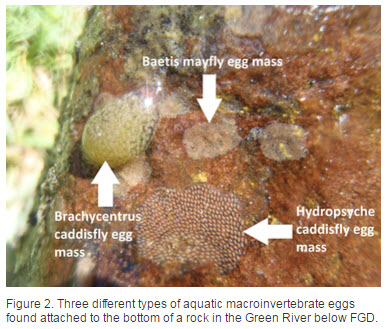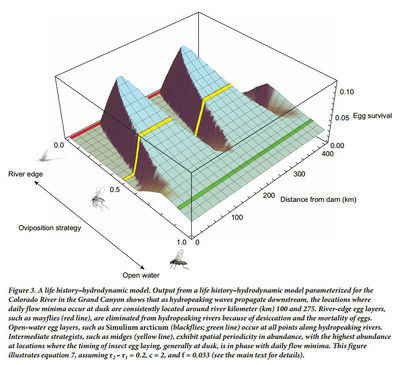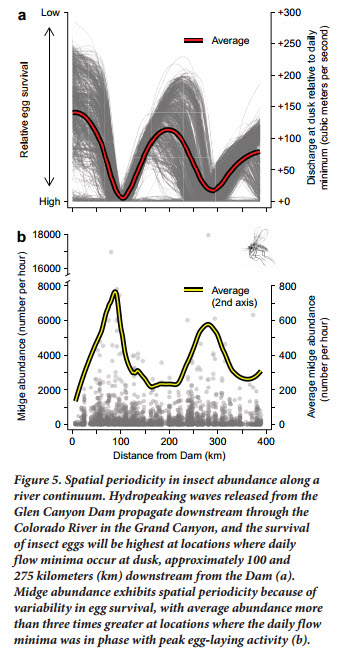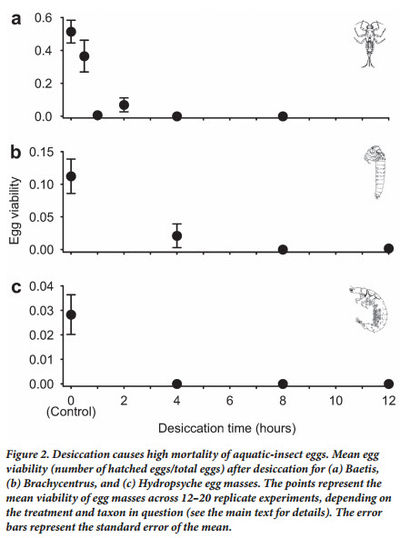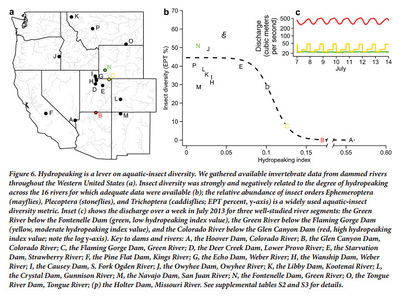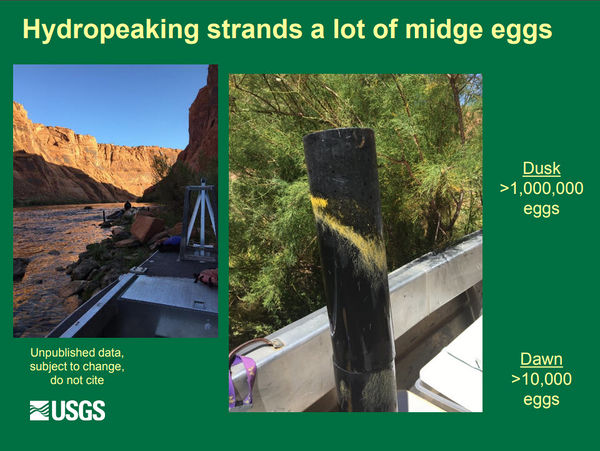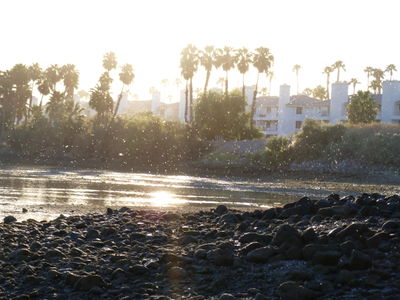Difference between revisions of "'''Oviposition and Egg Desiccation'''"
Cellsworth (Talk | contribs) |
Cellsworth (Talk | contribs) |
||
| (5 intermediate revisions by the same user not shown) | |||
| Line 17: | Line 17: | ||
</table> | </table> | ||
| + | [[File:MacroinvertEggmasses.jpg|center|400px]] | ||
<!-- | <!-- | ||
| Line 42: | Line 43: | ||
|style="color:#000;"| | |style="color:#000;"| | ||
| − | [[File:EPThydropeakingModel.jpg| | + | Aquatic insects exhibit complex life cycles that include egg, larval, adult, and, in some instances, pupal |
| − | [[File:MidgeAbundanceFlow.jpg|400px]] | + | stages. Disturbances at any of these life stages can affect overall population dynamics. Yet, efforts to understand |
| − | [[File:DesiccationMortality.jpg|400px]] | + | the effects of disturbances, such as hydrologic alterations, overwhelmingly focus on the larval life stage of aquatic |
| − | [[File:EPTdiversityHydropeaking.jpg|600px]] | + | insects. We evaluated the potential for load-following flows associated with hydroelectric power production to act |
| + | as a population bottleneck for aquatic insects via reductions in the availability and temporal persistence of optimal | ||
| + | oviposition habitats. Specifically, we quantified the oviposition habitat selectivity of Baetis spp. (Baetidae), Brachycentrus occidentalis (Brachycentridae), Chironomidae (Diptera), and Hydropsyche occidentalis (Hydropsychidae) downstream of Flaming Gorge Dam, Utah, USA. We found that all taxa except H. occidentalis preferentially laid | ||
| + | eggs on large emergent substrates located along the river edge. Peak discharge associated with load-following flows | ||
| + | substantially reduced the number of emergent substrates available for oviposition, and daily low flows exposed eggs | ||
| + | in these habitats to desiccation and drying. When subjected to experimental drying, both Baetis and H. occidentalis | ||
| + | eggs experienced nearly 100% mortality after 2 h, whereas most B. occidentalis remained viable after 8 h. Our paired | ||
| + | field and experimental results are consistent with the hypothesis that load-following flows from hydroelectric dams | ||
| + | produce a population bottleneck for aquatic insects by short circuiting recruitment processes. Environmental flows | ||
| + | that seek to improve the health of tailwater aquatic insect populations would benefit from consideration of habitat | ||
| + | requirements for all life stages of aquatic insects. [https://www.journals.uchicago.edu/doi/pdf/10.1086/710237] | ||
| + | |||
| + | [[File:EPThydropeakingModel.jpg|thumb|center|400px| [http://gcdamp.com/images_gcdamp_com/7/70/Kennedy_2016_HydropowerEPT.pdf BioScience Paper] ]] | ||
| + | [[File:MidgeAbundanceFlow.jpg|thumb|center|400px| [http://gcdamp.com/images_gcdamp_com/7/70/Kennedy_2016_HydropowerEPT.pdf BioScience Paper] ]] | ||
| + | [[File:DesiccationMortality.jpg|thumb|center|400px| [http://gcdamp.com/images_gcdamp_com/7/70/Kennedy_2016_HydropowerEPT.pdf BioScience Paper] ]] | ||
| + | [[File:EPTdiversityHydropeaking.jpg|thumb|center|400px| [http://gcdamp.com/images_gcdamp_com/7/70/Kennedy_2016_HydropowerEPT.pdf BioScience Paper] ]] | ||
| + | [[File:MidgeEggStranding.jpg|thumb|center|600px|https://www.usbr.gov/uc/rm/amp/twg/mtgs/17jan26/AR19_Kennedy.pdf]] | ||
|} | |} | ||
| Line 68: | Line 85: | ||
|- | |- | ||
|style="color:#000;"| | |style="color:#000;"| | ||
| + | |||
| + | '''2020''' | ||
| + | *[https://www.journals.uchicago.edu/doi/pdf/10.1086/710237 Miller et al. 2020. Macroinvertebrate oviposition habitat selectivity and egg-mass desiccation tolerances: Implications for population dynamics in large regulated rivers. Freshwater Science] | ||
'''2016''' | '''2016''' | ||
| − | |||
*[[Media:Kennedy 2016 HydropowerEPT.pdf| Kennedy et al. 2016. Flow Management for Hydropower Extirpates Aquatic Insects, Undermining River Food Webs. BioScience]] | *[[Media:Kennedy 2016 HydropowerEPT.pdf| Kennedy et al. 2016. Flow Management for Hydropower Extirpates Aquatic Insects, Undermining River Food Webs. BioScience]] | ||
| + | *[http://www.usu.edu/buglab/Projects/CurrentProjects/#item=123 Macroinvertebrate Oviposition (egg-laying) Habitat Preferences on the Green River below Flaming Gorge Dam] | ||
| + | *[[Media:Miller SFS C10 Hydroecology.pdf| Novel Hydrologic Regimes Disrupt Insect Life History Strategies: Effects of Hydropeaking on Insect Oviposition]] | ||
| + | *[[Media:USUTailwater 30Nov2016.pdf| Controls on the Structure and Function of Tailwater Macroinvertebrate Assemblages, USU progress report November 2016]] | ||
| + | *[[Media:Oviposition Poster Final.pdf| Oviposition Habitat Selectivity of Tailwater Macroinvertebrates: A Methodological Approach from the Colorado River Basin]] | ||
| + | *[[Media:20160218 FoodbaseBottleneck.pdf| A life history bottleneck for aquatic insects arising from load following]] | ||
| + | *[[Media:Poff Schmidt 2016 S How dams can go.pdf| How dams can go with the flow: Small changes to water flow regimes from dams can help to restore river ecosystems. By N. LeRoy Poff and John C. Schmidt | ||
| + | ]] | ||
|- | |- | ||
| Line 78: | Line 104: | ||
|style="color:#000;"| | |style="color:#000;"| | ||
| − | [[File: | + | [[File:P1020356.JPG|center|400px]] <br> |
| − | + | *Caddis hatch below Parker Dam. There are several species of EPT below Parker and Davis Dam in spite of daily fluctuations that exceed 6 feet per day. | |
| − | + | At least three genera of caddisflies and one genus of mayfly were collected in drift and benthic samples downstream of Davis and Parker Dams. These are species of a net-spinning caddisfly in the family Hydropsychidae (Smicridea), a case-building caddisfly in the family Leptoceridae (Nectopsyche), microcaddisflies in the family Hydroptilidae, and a swimming mayfly in the family Baetidae (Baetis). Hydroptilidae are found in light trap samples downstream of Lees Ferry in Grand Canyon, and are common in Arizona streans and rivers (Blinn and Ruiter, 2009). They are nonetheless very small (as indicated by its common name): at under 5 mm in total length (Merritt and others, 2008), generally smaller even than midge (Chironomidae) larvae, and therefore not a valuable prey item for fish. The genus Smicridea spins silk nets for capturing floating particles or organic matter suspended in the water column. For this reason, its family, in general, is common in tailwaters, where they can achieve great densities (Nakano and Strayer, 2014). In fact, Smicridea specifically is a documented pest species in the Parker Dam tailwater and in the Central Arizona Project canals carrying water to the Phoenix metropolitan area (D. Ruiter, personal communication). Baetis mayflies are one of the more common genera in aquatic ecosystems (Merritt and others, 2008); like midges, they are virtually ubiquitous in freshwater habitats. Relatively less information is currently available about the Nectopsyche caddisflies found in these sites, pending further literature research. (2016 GCMRC trip summary to WAPA) | |
| − | + | ||
|} | |} | ||
Latest revision as of 14:23, 14 August 2020
|
|
Oviposition and Egg Desiccation Studies below Flaming Gorge and Glen Canyon DamsKennedy's 2016 Bioscience paper presents a conceptual model describing how hydropower flows could be limiting aquatic insect diversity and production by limiting the reproductive success of insects accustom to laying their eggs along the shoreline. It provides supporting data from an egg desiccation study done below Flaming Gorge Dam, light trap data collected in the Grand Canyon, and a comparison of fluctuation intensity and EPT diversity in several western US hydropower tailwaters. The paper concludes that egg desiccation from fluctuating flows is likely a leading factor in limiting aquatic insect diversity and production in tailwaters below hydropower facilities. The paper also proposes a bugflow experiment to be tested at Glen Canyon Dam as a possible mitigation for fluctuating flows made for hydropower production. |
| -- |
-- |
-- |
|---|
|
|
